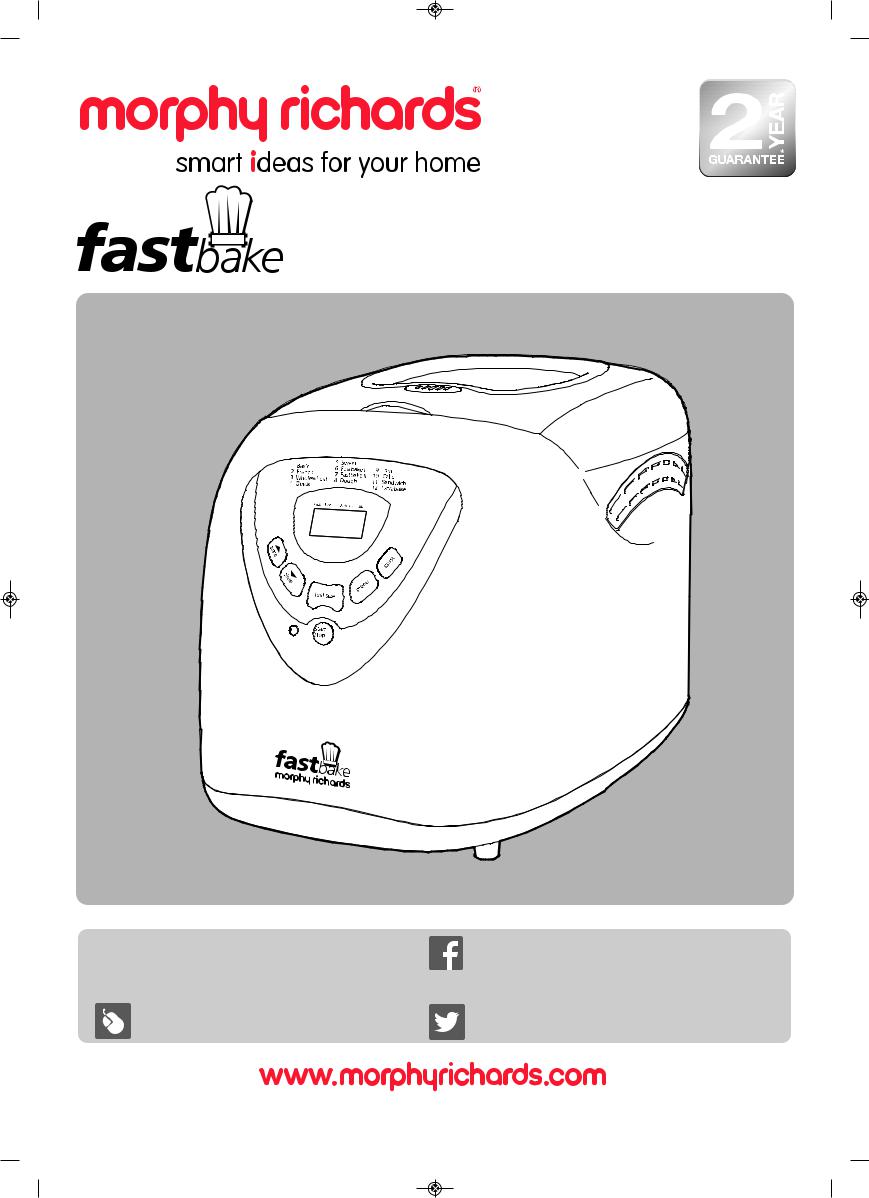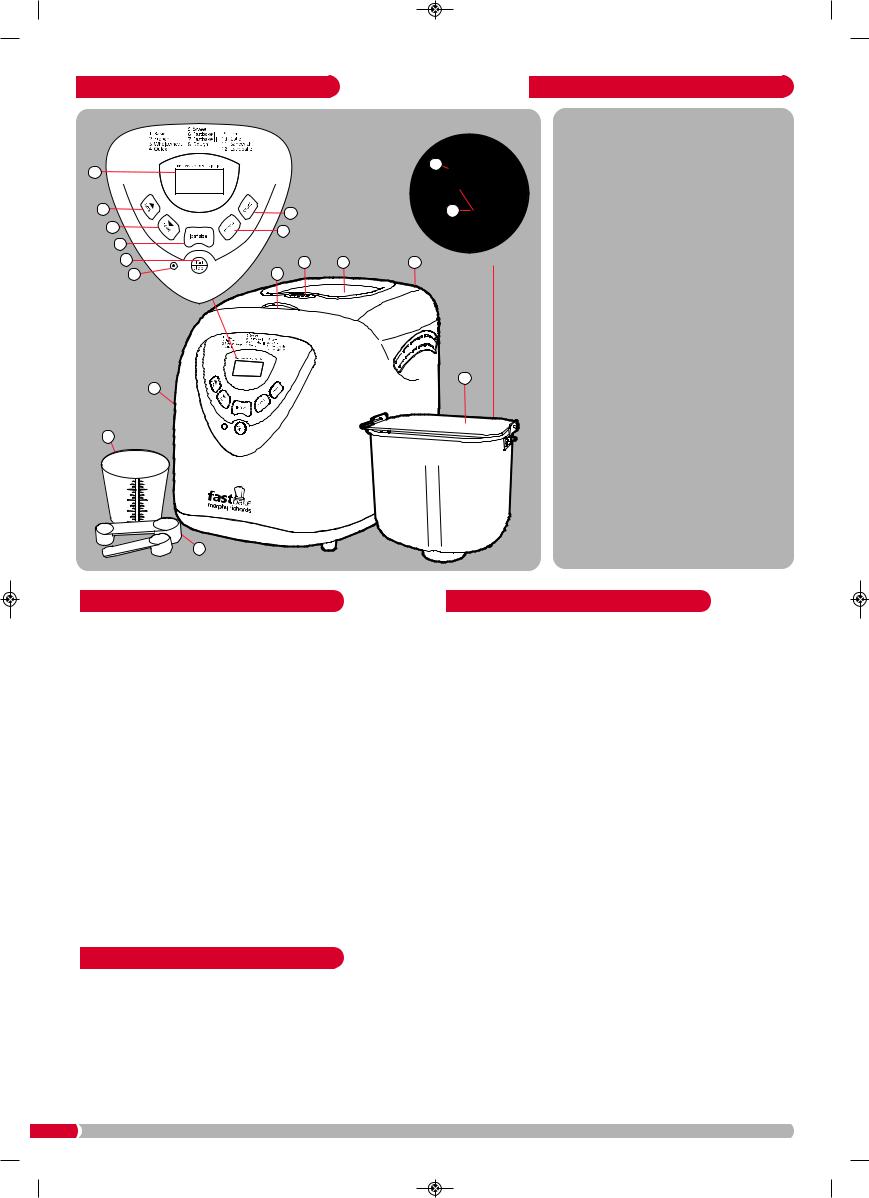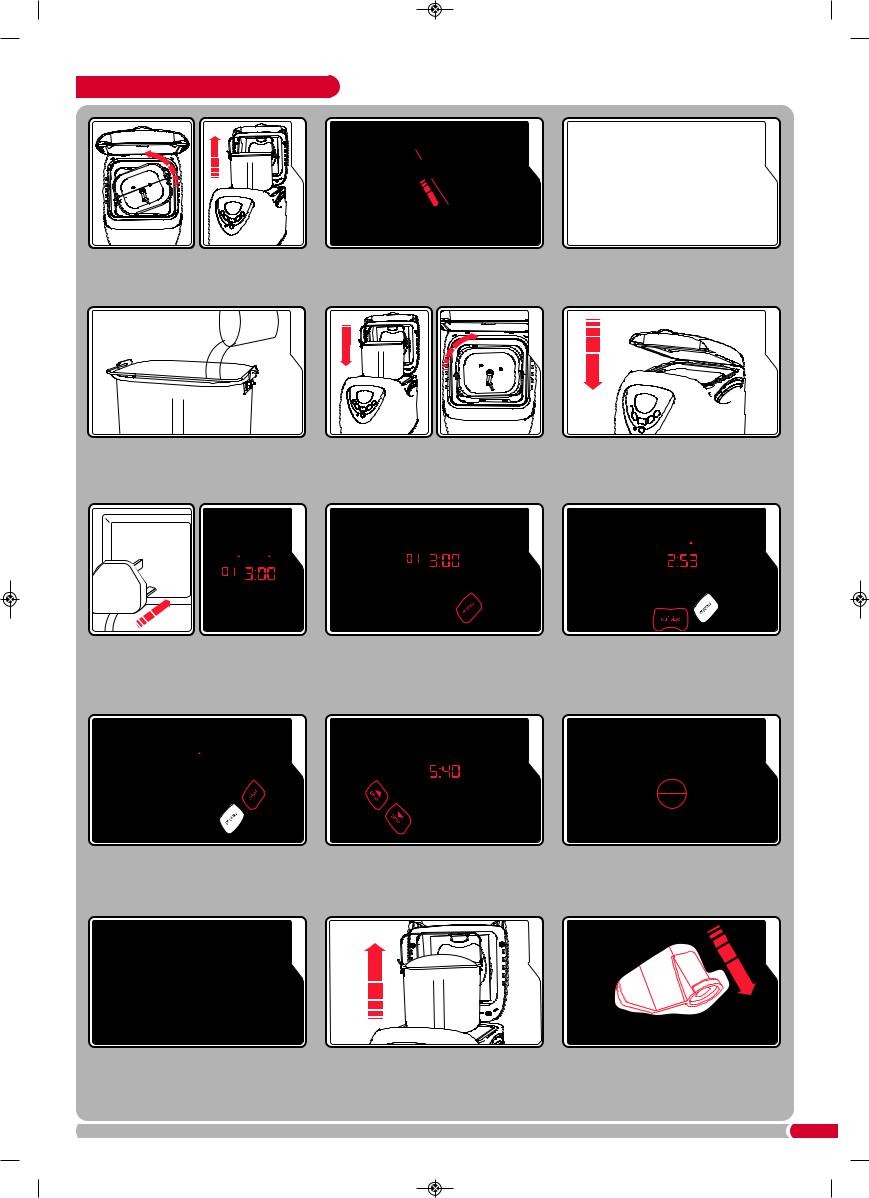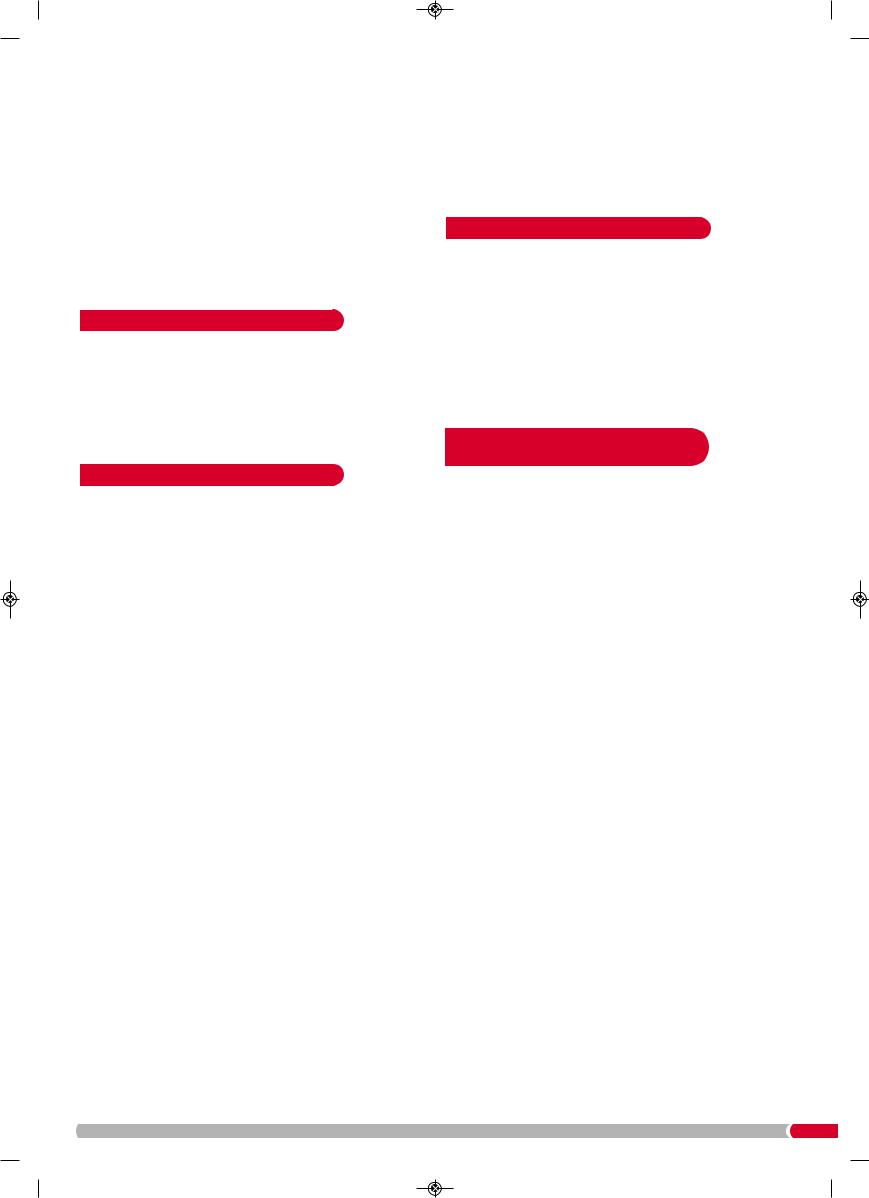Morphy Richards 48281 Instruction manual

BM48281 MUK Rev 8
Breadmaker |
 Please read and keep these instructions for future use
Please read and keep these instructions for future use
For competitions, product hints and tips |
www.facebook.com/morphyrichardsuk |
|
and more join us at |
||
|
||
www.morphyrichards.co.uk/blog |
@loveyourmorphy |
|
|
|
* Register online for your 2 year guarantee. See the back of this instruction book for details (UK and Ireland customers only).

Health And Safety
The use of any electrical appliance requires the following common sense safety rules.
Please read these instructions carefully before using the product.
•This appliance can be used by children aged from 8 years and above and persons with reduced physical, sensory or mental capabilities, or lack of experience and knowledge, if they have been given supervision or instruction concerning the use of the appliance in a safe way and understand the hazards involved. Children shall not play with the appliance. Cleaning and user maintenance shall not be made by children unless they are older than 8 and supervised.
•Keep the appliance and its cord out of reach of children less than 8 years.
•For care and cleaning refer to page 21.
•This appliance is intended to be used in household and similar applications such as: farm houses, by clients in hotels, motels and other residential type environments, bed and breakfast type environments. It is not suitable for use in staff kitchen areas in shops, offices and other working environments.
•If the supply cable is damaged, it must be replaced by the manufacturer, its service agent or similarly qualified persons in order to avoid a hazard.
•This appliance is not intended to be operated by means of an external timer or separate remote control system.
•Do not exceed the maximum quantities of flour and raising agent stated in recipes.
In addition, we offer the following safety advice.
Location
•Always locate your appliance away from the edge of a worktop.
•Ensure that the appliance is used on a firm, flat surface.
•Do not use the appliance outdoors, or near water.
•Do not place the appliance on or near heat sources such as gas or electric stove, ovens, or burners.
Mains Cable
•The mains cable should reach from the socket to the base unit without straining the connections.
•Do not let the mains cable hang over the edge of a worktop where a child could reach it.
•Do not let the cable run across an open space e.g. between a low socket and table.
•Do not let the cable run across a cooker or toaster or other hot area which might damage the cable.
Personal Safety
•WARNING: To protect against fire, electric shock and personal injury, do not immerse cord, plug or appliance in water or any other liquid.
•WARNING: Do not touch hot surfaces. Use oven mitts or oven gloves when removing the hot bread pan. Do not cover the steam vent openings under any circumstances.
•WARNING: Misuse of appliance could cause injury.
•WARNING: Avoid contact with moving parts.
•Extreme caution must be observed when moving an appliance with hot contents.
•Do not use the appliance with wet or moist hands.
Treating Scalds
•Run cold water over the affected area immediately. Do not stop to remove clothing, get medical help quickly.
Other Safety Considerations
•The use of accessory attachments not recommended by the manufacturer may cause damage to the Breadmaker.
•To avoid damaging the appliance, do not place the baking pan or any object on top of the unit.
•Do not clean with scouring pads. Do not wash the Baking Pan, Kneading Blade, Measuring Cup or Spoons in a dishwasher.
•Keep the appliance and the cable away from heat, direct sunlight, moisture and sharp edges.
•The baking pan must be in place prior to switching on the appliance.
•Always remove the plug from the socket whenever the machine is not in use, when attaching accessory parts, cleaning the machine or whenever a disturbance occurs. Pull on the plug, not the cable.
Electrical Requirements
Check that the voltage on the rating plate of your appliance corresponds with your house electricity supply which must be A.C. (Alternating Current).
Should the fuse in the mains plug require changing a 13 amp BS1362 fuse must be fitted.
WARNING: THIS APPLIANCE MUST BE EARTHED.
2

Introduction
Thank you for your recent purchase of a Morphy Richards Breadmaker. As you will soon find out there is nothing like the aroma of fresh homemade bread throughout your home.
We understand you will be keen to get cracking with your new breadmaker but please contain that excitement for a little longer and take some time to familiarise yourself with your new breadmaker, what you need to do before you first use your machine and review our baking hints and tips to create perfect breads and cakes. If you carefully read through this instruction booklet we are confident you will be able to produce fantastic results time after time.
Contents |
|
Health And Safety ........................................... |
2 |
Introduction ..................................................... |
3 |
Product Overview .......................................... |
4 |
Features ........................................................... |
4 |
Before First Use .............................................. |
4 |
About This Breadmaker .................................. |
4 |
Feature Overview ............................................ |
4 |
Using Your Breadmaker .................................. |
5 |
Programme Descriptions ................................ |
6 |
Using The Delay Timer .................................... |
6 |
Beeper .............................................................. |
6 |
Power Interruption ........................................... |
6 |
Hints And Tips .................................................. |
6 |
Temperatures .................................................. |
7 |
Measuring Ingredients ..................................... |
7 |
Understanding Baking .................................... |
7 |
Using The Right Ingredients - Flour ............... |
7 |
Using The Right Ingredients - Other |
|
Ingredients ..................................................... |
8 |
Glazes ............................................................. |
8 |
Bread Mix ....................................................... |
8 |
Baking Your Own Bread ................................ |
9 |
Conversion Charts ......................................... |
17 |
Baking Cycle Times ....................................... |
18 |
F.A.Q.s ........................................................... |
18 |
Troubleshooting ............................................ |
19 |
Care And Cleaning ........................................ |
21 |
Contact Us .................................................... |
21 |
Notes ............................................................. |
22 |
Guarantee ...................................................... |
24 |
Recipes |
|
Basic - 1 ........................................................... |
10 |
French - 2 ......................................................... |
11 |
Wholewheat - 3 ................................................ |
11 |
Quick - 4 ........................................................... |
11 |
Sweet - 5 ........................................................ |
12 |
Fastbake I - 6 .................................................. |
12 |
Fastbake II - 7 .................................................. |
12 |
Dough - 8 ........................................................ |
12 |
Jam - 9 ........................................................... |
13 |
Cake - 10 ......................................................... |
14 |
Sandwich - 11 ................................................. |
14 |
Gluten Free ....................................................... |
15 |
3

Product Overview |
|
|
|
Features |
|
|
|
|
|
(1) |
Lid Handle |
|
|
|
|
(2) |
Air Vent |
9 |
|
7 |
|
(3) |
Viewing Window |
|
|
|
(4) |
Lid |
|
|
|
|
|
||
10 |
15 |
|
8 |
(5) |
Main Unit |
|
(6) |
Baking Pan |
|||
11 |
16 |
|
|
||
|
|
|
|
|
|
12 |
|
|
|
(7) |
Kneading Blade |
13 |
3 |
4 |
|
(8) |
Rotating Shaft |
14 |
|
||||
|
|
|
(9) |
LCD Screen |
|
|
|
|
|
||
|
|
|
|
(10) |
Time Increase Button |
|
|
|
|
(11) |
Time Decrease Button |
|
|
|
|
(12) |
Loaf Size Button |
|
|
|
|
(13) |
Start / Stop Button |
|
|
|
6 |
(14) |
Baking Light |
5 |
|
|
|
||
|
|
|
|
(15) |
Crust Button |
17 |
|
|
|
(16) |
Menu Button |
|
|
|
(17) |
Measuring Cup |
|
|
|
|
|
||
|
|
|
|
(18) |
Measuring Spoons |
18
Before First Use
Before first use, please take a few minutes to read this instruction book and find a place to keep it handy for future reference. Please pay particular attention to the safety instructions.
1.Wash the Baking Pan (6), Kneading Blade (7) in hot soapy water, dry thoughly.
2.Wipe the outside surface of the Main Unit (5) with a clean, damp cloth.
DO NOT use scouring pads or any abrasives on any part of the Breadmaker.
3.If using for the first time, use oil, butter or margarine to grease the Baking Pan and bake empty for about 10 minutes on the Extra Bake program.
4.Clean with a damp cloth again.
5.Place the Kneading Blade on the Rotating Shaft (8) in the Baking Pan.
During manufacturing it is necessary to lightly grease some parts of the appliance. This may result in the unit emitting some vapour when first used, this is normal.
Feature Overview
LCD Screen (9)
Allows you to view the browning level, loaf weight, and programme selected. It also shows a countdown timer indicating the time left before completion (3:20, for example, is 3 hours and 20 minutes; 0:20 is 20 minutes.)
Timer delay buttons (10), (11)
Can be used to delay the start of bread making process, so the baking process completes when you require. (All programs except Fastbake and Jam).
Loaf size button (12)
For selecting the small (1.5lb) or large (2lb) loaf size (certain programs only).
Start (13)
Press and hold for approximately 1 second to start, a beep sounds and the colon (:) flashes before the program starts.
Stop (13)
Press and hold for approximately 2 seconds to stop the baking process, a beep sounds to confirm.
About This Breadmaker
•The breadmaker has two settings to make either a small (1.5lb / 680g) or large (2lb / 907g) loaf (approximate weight, dependant upon recipe).
•A fruit and nut beep signals when extra ingredients, such as fruit and nuts, can be added so they don’t get chopped by the kneading blade.
•The 1.5lb setting can be used to make a 1lb loaf for some of the recipes.
4
Crust button (15)
For selecting the crust colour from light, medium or dark (selected programs only).
Menu button (16)
For choosing your desired bread making programme.

Using Your Breadmaker
1
Twist the Baking Pan (6) anti clockwise to unlock. Remove from the Main Unit
(5).
4
Important: Use tepid water (21-28oC). When adding the yeast, ensure it doesnt come into contact with the water, or it will activate.


 7
7
2
Attach the Kneading Blade (7) to the Rotating Shaft (8) by pushing it on.

 5
5
Put the Baking Pan back into the Main Unit, turning clockwise to lock into place. Ensure it is secured correctly.
8
3
Water |
11⁄8 cup(270ml) |
Skimmed milk powder |
21⁄2 tbsp |
Sunflower oil |
21⁄2 tbsp |
Sugar |
21⁄4 tbsp |
Salt |
11⁄4 tsp |
Strong white bread flour |
3 cup (432g) |
|
|
Fast action yeast |
11⁄4 tsp |
Carefully measure the ingredients and add to the Baking Pan in the order listed in the recipe.
6
Close the Lid (4).
9
Plug the Breadmaker into the mains outlet. The Breadmaker will automatically default to the basic setting and normal time.
10
Select the desired programme by pressing the Menu Button (16). Every time you press a button you will hear a beep to confirm.
11
Press the Loaf Size Button (12), to choose between the small (1.5lb) or large (2lb.) loaves. For 1lb loaves use the small setting.
12
Choose the desired crust colour by pressing the Crust Button (15).
13
If you wish to delay the start time, set the delay now. Use the Increase and Decrease Time Buttons (10), (11) to adjust the time.
14
start stop
Press the Start/Stop Button (13) to start the machine, the Breadmaker will beep, the colon (:) will flash and the Baking Light (14) will illuminate.
15
The Breadmaker will beep when finished and the display will show 0:00. It will automatically switch to Keep Warm for 60 minutes.
WARNING: USE OVEN GLOVES Switch the Breadmaker off at the wall. Lift the Lid and remove the Baking Pan. Allow to cool.
Remove the loaf and allow to cool fully on a wire rack. Remove the Kneading Blade from the base of the loaf using a non metal implement before cutting.
5

Programme Descriptions
1 Basic
For white and brown breads. Can also be used for flavoured breads with added herbs and raisins. Gluten Free Bread.
2 French
For the baking of light weight bread such as french bread which has a crisper crust and lighter texture.
3 Wholewheat
For the baking of bread containing significant amounts of wholewheat. This setting has longer preheat time to allow the grain to soak up the water and expand. It is not advised to use the delay timer as this can produce poor results.
4 Quick
For white bread that is required in a shorter time. Bread baked on this setting is usually smaller with a dense texture.
5 Sweet
For the baking of sweet bread which gives a crisper crust than on basic setting. The crisper crust is produced by the sugar ‘burning’.
6 Fastbake I
For preparation of a 1.5lb white loaf in a reduced time period. Loaves made on this setting can be shorter and the texture more moist.
7 Fastbake II
For preparation of a 2lb white loaf in a reduced time period. Loaves made on this setting can be shorter and the texture more moist.
8 Dough
This setting only makes the dough and will not bake the final bread. Remove the dough and shape it to make bread rolls, a pizza base, etc. Any dough can be prepared on this setting.
Do not exceed (1kg / 2lb) of combined ingredients.
9 Jam
Use this setting for making jam and marmalade. Do not increase the quantity or allow the recipe to boil over the pan into the baking chamber. Should this happen, stop the machine immediately. Remove the pan carefully, allow to cool a little and clean thoroughly.
10 Cake
This setting will mix ingredients and then bake for a preset time. It is required to mix two groups of ingredients before adding to the Breadmaker (see cake recipes on pages
14 & 16).
11 Sandwich
This is to bake light texture bread but with a softer, thicker crust.
12 Extra Bake
This setting is bake only and can be used to increase the baking time on selected settings. This is especially useful to help ‘set’ jams and marmalade. When started, the default time is 1 hour (1:00) minimum and counts down in 1 minute intervals.You will have to manually switch this off by pressing the stop button, when you have completed the Extra bake process, It is advised that you check the progress of the bread or jam at 10 minute intervals. This may be before the 1 hour bake period is compeleted.
6
When selecting Extrabake straight after another program, if the message H:HH is displayed, open the Lid (4), remove the Baking Pan (6) and allow to cool for 10 minutes. When cool, replace the Baking pan and its contents, set program and press start.
Using The Delay Timer
The timer can be used to delay the start of the baking programme, perfect for fresh bread first thing in the morning. A maximum of 13 hours can be set. Do not use this function with recipes that use perishable ingredients such as eggs or fresh dairy produce.
1Decide when you want the bread to be ready and calculate the difference in time between now and then. For example, if you want a loaf at 8am, and it is now 7.30pm, the difference is 121⁄2 hours.
2Enter this time by pressing the Time Increase and Decrease Butons (10),(11). This will adjust the time in 10 minute increments. When set to the correct time (e.g. 12:30,) press the Start/Stop Button (13), the colon (:) will flash.
•If you have selected the wrong time press and hold the Start / Stop Button for 2 seconds to cancel.
The timer will go back to the program time stage. Repeat steps 1 and 2.
•The timer delay is up to a maximum of 13 hours.
Beeper
The beeper sounds:
•When pressing any button.
•During the second kneading cycle of certain programs to indicate that cereals, fruit, nuts or other ingredients can be added.
•When the programme finishes.
•When keep warm finishes.
Power Interruption
After a brief power supply failure:
•If the programme has not yet reached rise 1, press Start and the programme will continue using the automatic repeat function;
•If it has gone beyond this point, the ingredients will have to be discarded and you must start again with fresh ingredients.
Hints And Tips
•Place all recipe ingredients into the Baking Pan (6) so that the yeast is not touching any liquid.
•If you are using the machine on the Dough setting (programme 8), after the cycle is complete, remove the dough from the Breadmaker, keeping the dough inside the Baking Pan. Cover in a thin coating of sunflower oil, cover with greaseproof paper and a dry tea towel. The dough should then be left in a warm area free from draughts, for approximately 30 minutes, or until it has roughly doubled in size.
•Humidity can cause problems, therefore humidity and high altitudes require adjustments. For high humidity, add an extra tablespoon of flour if the consistency is not right. For high altitudes,decrease the yeast amount by approximately 1/4 teaspoon, and decrease the sugar and/or water or milk quantity slightly.
•When recipes call for a ‘lightly floured surface’ use about 1 to 2 tablespoons (tbsp) of flour.You may want to lightly flour your fingers or rolling pin as well for easier handling.

•If the dough you are rolling shrinks back, let it rest covered for a few minutes before rolling again.
•Dough may be wrapped in plastic and stored in a freezer for later use. Thaw and bring to room temperature before using.
•After 5 minutes of kneading, open the Lid (4) and check the dough consistency. The dough should form a soft, smooth ball. If too dry, add liquid. If too wet, add flour (1/2 to 1 tablespoon at a time).
•Since homemade bread has no preservatives it tends to dry out and become stale faster than commercially made bread.
•Do not open the Lid whilst the Breadmaker is operating as this will affect the quality of the bread, especially its ability to rise properly. Only open the Lid when the recipe needs you to add additional ingredients (see recipes).
Temperatures
The Breadmaker will work well in a wide range of temperatures, but there could be a difference in loaf size between a very warm room and a very cold room. We recommend the room temperature should be between 15ºC and 34ºC. All ingredients, and liquids (water or milk), should be warmed to room temperature 21°C (70°F). If ingredients are too cold, below 10°C (50°F), they will not activate the yeast. Hot liquids, above 40°C (104°F), may kill the yeast.
Measuring Ingredients
The most important step when using your Breadmaker is measuring your ingredients precisely and accurately. It is extremely important to measure liquid and dry ingredients properly or it could result in a poor baking result. Do not use normal kitchen teaspoons (tsp) or tablespoons (tbsp). The ingredients must also be added into the Baking Pan in the order in which they are given in each recipe. Liquid and dry ingredients should be measured as follows:
Measuring Cup (17)
The cup is marked in various ‘volume measurement’ scales. The recipes in this book use the ‘cup’ volume which is equal to 8 floz and is marked in 1/16 divisions.
If you want to use weight measurement you must use a good quality set of digital scales, we prefer to use the ‘cup’ measure for consistency and accuracy.
Liquid Measurements
Use the Measuring Cup (17) provided. When reading amounts, the measuring cup must be placed on a horizontal flat surface and viewed at eye level (not on an angle). The liquid level line must be aligned to the mark of measurement.
Dry Measurements
Dry measurements must be done using the Measuring Cup provided or using a set of digital weighing scales. Dry measuring must be done by gently spooning ingredients into the measuring cup and then once filled, levelling off with a knife. Tapping a measuring cup will pack the ingredients and you will end up with more than is required. This extra amount could affect the balance of the recipe. Do not sift the flour, unless stated.
When measuring small amounts of dry or liquid ingredients there are two Measuring Spoons (18), with the following capacities - 1 tablespoon (tbsp), 1 teaspoon (tsp) and 1/4 teaspoon (tsp). Measurements must be leveled off, not heaped as this small difference could throw out the critical balance of the recipe.
This machine requires that you carefully follow the recipe instructions. In basic cooking, normally ‘a pinch of this and a dash of that’ is fine, but not for breadmakers. Using an automatic Breadmaker requires you to accurately measure
each ingredient for best results.
•Always add ingredients in the order they are listed in the recipe.
•Please note that the measuring cups are based on the American standard 8 fluid ounce cup, NOT the 10 fluid ounce British cup.
•Accurate measuring of ingredients is vital. Do not use larger amounts.
Understanding Baking
It is often said that cooking is an art relying on the creativity of the chef, while baking bread is much more of a science. This means that the process of combining flour, water and yeast, results in a reaction that produces bread.You have to remember that when the ingredients combine with each other they produce a specific result. Read the following information carefully to gain a better understanding of the importance each ingredient plays in the breadmaking process. In all of the recipes you create yourself, never exceed a total amount of 5 cups of dry ingredients (that includes the total amount of flour, oats, oatmeal, bran.) Also do not exceed the total amount of 3 teaspoons (tsp) of yeast and 5 teaspoons of baking powder.
Using The Right
Ingredients - Flour
Flours, while visibly similar, can be very different by virtue of how they were grown, milled and stored.You may find that you will have to experiment with different brands of flour to help you make that perfect loaf. Storage is also very important, as all flours should be kept in an airtight container.
All Purpose Flour/Plain Flour
All purpose flour is a blend of refined hard and soft wheat flours especially suitable for making cake. This type of flour should be used for recipes in the cake/quick bread section.
Strong White Flour/Bread Flour
Bread flour is a high gluten/protein flour that has been treated with conditioners that give dough a greater suitability for kneading. Bread flour typically has a higher gluten concentration than All purpose flour; however, depending on different milling practices, this may vary. Strong plain flour or bread flour are recommended for use with this Breadmaker.
Wholewheat Flour/ Wholemeal Flour
Wholewheat flour/wholemeal flour is milled from the entire wheat kernel which contains the bran and germ and makes it heavier and richer in nutrients than white flour. Breads made with this flour are usually smaller and heavier than white loaves.
To overcome this wholewheat flour/wholemeal flour can be mixed with Bread flour or strong plain flour to produce a lighter textured bread.
Self-Raising Flour
Self-raising Flour contains unnecessary leavening ingredients that will interfere with bread and cake making.
It is not recommended for use.
Bran
Bran (unprocessed) & Wheat Germ are the coarse outer portions of the wheat or rye grains separated from flour by sifting or bolting. They are often added in small quantities to bread for nutritional enrichment, heartiness and flavour. They are also used to enhance the texture of bread.
Oatmeal
Oatmeal comes from rolled or steel-cut oats. They are used primarily to enhance flavour and texture.
7

Using The Right
Ingredients - Others
Yeasts (Active Dry Yeast)
Yeast through a fermentation process produces gas (carbon dioxide) necessary to make the bread rise.Yeast must be able to feed on sugar and flour carbohydrates in order to produce this gas. There are three different types of yeast available: fresh, traditional dry active, and fast action. It is recommended that fast action yeast be used for the recipes in this book. Fresh or compressed cake yeast is not recommended as they will produce poor results. Store yeast according to manufacturers instructions. Ensure your yeast is fresh by checking its expiration date. Once a package or can of yeast is opened it is important that the remaining contents be immediately resealed and refrigerated for future use. Often bread or dough, which fails to rise is due to stale yeast being used. The following test can be used to determine whether your yeast is stale and inactive:
1Place half a cup of lukewarm water into a small bowl or cup.
2Stir 1 tsp. of sugar into the water then sprinkle 2 tsp. of yeast over the surface.
3Place bowl or cup in a warm area and allow to sit for 10 minutes undisturbed.
4The mixture should foam and produce a strong yeast aroma. If this does not occur, discard mixture and start again with another packet of dried yeast.
Sugar
Sugar is important for the colour and flavour of breads. It is also food for the yeast as it is part of the fermentation process.
Artificial sweeteners cannot be used as a substitute for sugar as the yeast will not react properly with them.
Salt
Salt is necessary to balance the flavour of breads and cakes, as well as for the crust colour that develops during baking. Salt also limits the growth of yeast so the amounts shown in the recipes should not be increased. For dietary reasons it may be reduced, however, your baking may suffer.
Liquids/Milk
Liquids such as milk or a combination of powdered milk and water, can be used when making bread. Milk will improve flavour, provide a velvety texture and soften the crust, while water alone will produce a crispier crust. Some liquids call for juice (orange, apple, etc) to be added as a flavour enhancer.
Note: For most recipes we suggest the use of dry (powdered) skimmed milk.
Eggs
Eggs add richness and a velvety texture to bread doughs and cakes.
Sunflower Oil
‘Shortens’ or tenderises the texture of yeast breads. Butter or margarine can be used as a substitute. If butter or margarine is used direct from the refrigerator it should be softened first for easier blending during the mixing cycle.
Baking Powder
Baking powder is a raising agent used in cakes. This type of raising agent does not require rising time before baking as the chemical reaction works when liquid ingredients are added.
8
Bicarbonate Of Soda
Bicarbonate of soda is another raising agent, not to be confused or substituted with baking powder. It also does not require rising time before baking as the chemical reaction works during the baking process.
Glazes
Give your just baked bread a professional finish. Select one of the following special glazes to enhance your bread.
Egg Glaze
Beat 1 large egg and 1 tablespoon of water together, brush generously.
Note: apply only to doughs before baking. *Not recommended for Gluten Free Breads.
Melted Butter Crust
Brush melted butter over just baked bread for a softer, tender crust.
Milk Glaze
For a softer, shiny crust, brush just baked bread with milk or cream.
Sweet Icing Glaze
Mix 1 cup sifted icing sugar with 1 to 2 tablespoons of milk to make a glaze consistency and drizzle over raisin bread or sweet breads.
Poppy/Sesame/Caraway Seeds/Oatmeal
Sprinkle your choice of these seeds generously over just glazed bread.
Bread Mix
Follow the information for bread mixes on the bread mix packet. Some brands of bread mixes recommend the use of the basic programme setting. There are 2 types of bread mixes currently available.
Just Add Water
These mixes are complete and they have all the necessary ingredients provided, even the yeast.You only add water.
•IMPORTANT: Follow the packet instructions as some mixes contain more than the normal amount of yeast, which could over rise in the Baking Pan. Use a maximum of 3 cups of mix.
•These mixes are more prone to over-rising and collapsing when the weather is hot and humid. Since these mixes are complete, we cannot advise how to adjust. Bake in the coolest part of the day, use water between 21-28°C.
Just Add Flour And Water
These mixes have the necessary ingredients in separate sachets. Remember strong white bread flour is required. A packet of this mix will produce a 700g (1.5 lb.)
